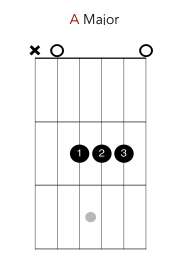2.2 The Amajor, Dmajor and Emajor chords
You’re going to need a few more chords to play a full song, so have a look at D and E as well as A. Basic major chords are generally written as a single letter; so ‘A’ refers to A major.
Notice how I’m reaching my thumb over the top of the neck, resting it lightly on the low E string to mute it.
Tips on changing between chords
You might be finding that it’s taking you a while to change from one chord to another. A good approach to chord changes is to look at which fingers have to move the least from one chord to the next, and plan the change around the movement of that finger.
Example 1:
As you can see from the diagrams above, in moving from A to D, your third finger stays on the B string, but moves up one fret; from the second fret to the third.
So to move from A to D:
- take off your first and second fingers
- slide your third finger up to the third fret (your entire left and will move about a centimeter up the neck.
- simultaneously plant your first and second fingers on the second fret of the G and e strings, respectively.
Example 2:
Using the same approach, in moving from D to E, your first finger stays on the G string, but moves down one fret; from the second fret to the first.
So to move from D to E:
- take off your second and third fingers slide your first finger down to the first fret as you move your first finger, rotate your wrist slightly anti-clockwise, opening your palm towards the ceiling. This change of hand position will make it easier to now simultaneously place your second finger on the second fret of the A string, and your third finger on the second fret of the D string.
Example 3: Moving from E back to A, there aren’t any fingers that can remain on the same string, however your second and third fingers remain on successive strings on the second fret.
So to move from E to A:
take off your second and third fingers
rotate your wrist slightly clockwise, this will help in moving your second and third fingers down two strings each, onto the G and B strings.
the wrist rotation will also help in getting your first finger to the second fret of the D string.



